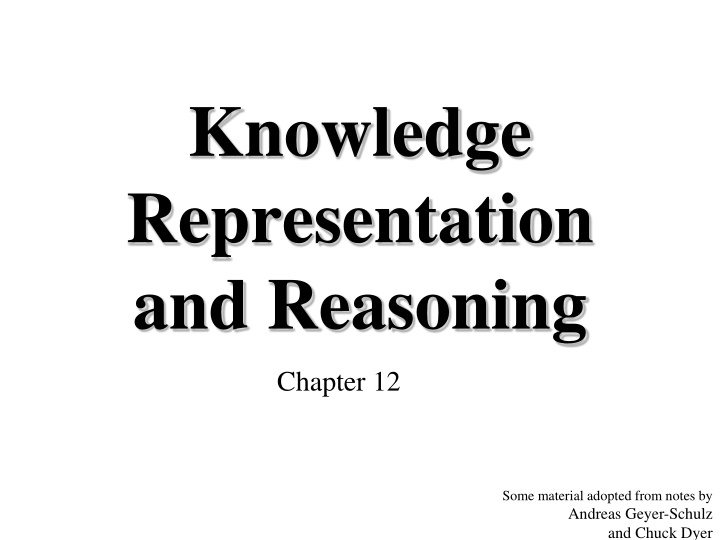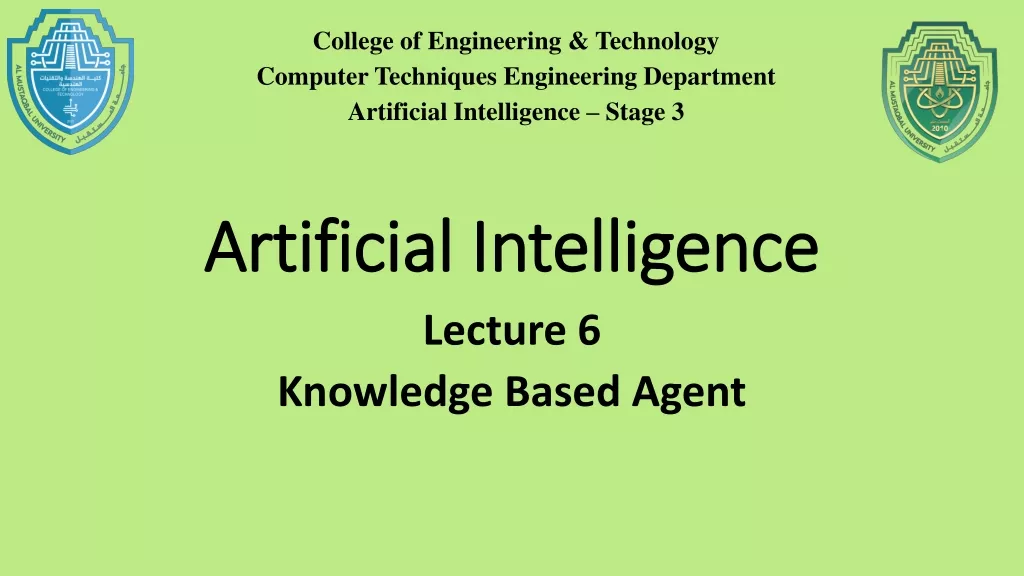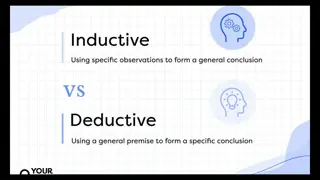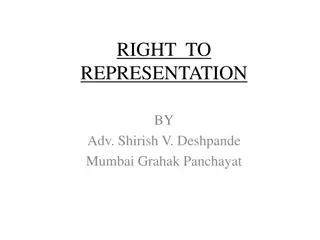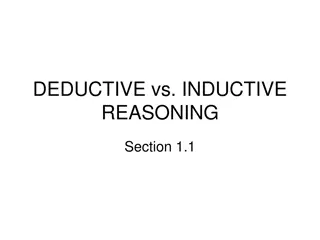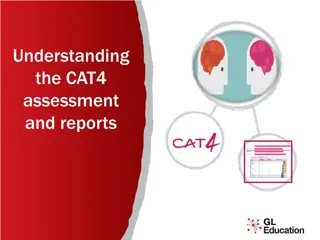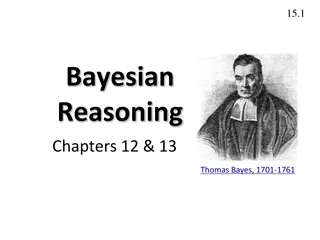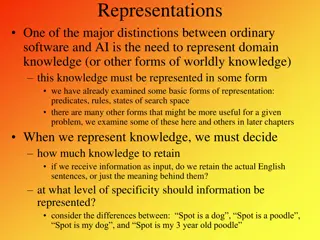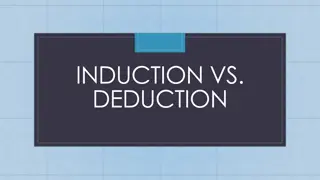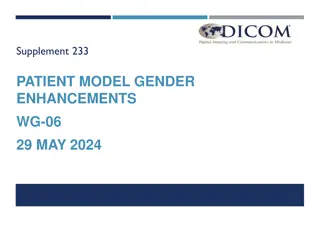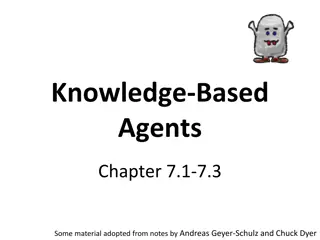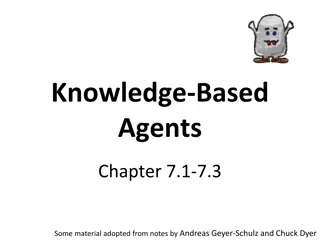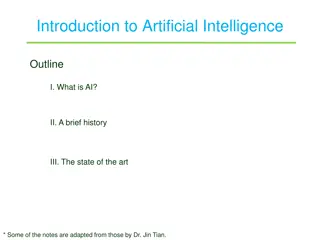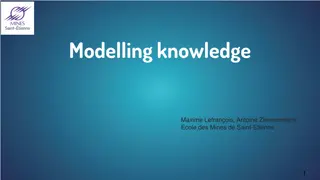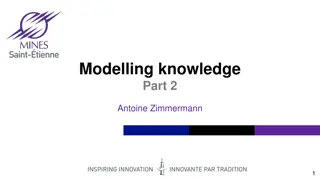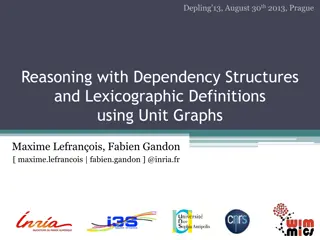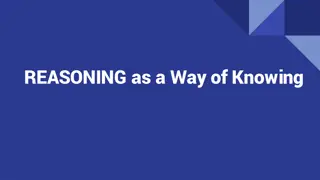Knowledge Representation and Reasoning
This chapter delves into different approaches to representing knowledge, including deductive methods, semantic networks, abduction, Bayesian reasoning, and non-monotonic reasoning. It explores deduction, abduction, and induction, with a focus on abductive reasoning and its applications in scenarios like medical diagnosis.
Download Presentation

Please find below an Image/Link to download the presentation.
The content on the website is provided AS IS for your information and personal use only. It may not be sold, licensed, or shared on other websites without obtaining consent from the author.If you encounter any issues during the download, it is possible that the publisher has removed the file from their server.
You are allowed to download the files provided on this website for personal or commercial use, subject to the condition that they are used lawfully. All files are the property of their respective owners.
The content on the website is provided AS IS for your information and personal use only. It may not be sold, licensed, or shared on other websites without obtaining consent from the author.
E N D
Presentation Transcript
Knowledge Representation and Reasoning Chapter 12 Some material adopted from notes by Andreas Geyer-Schulz and Chuck Dyer
Overview Approaches to knowledge representation Deductive/logical methods Forward-chaining production rule systems Semantic networks Frame-based systems Description logics Abductive/uncertain methods What s abduction? Why do we need uncertainty? Bayesian reasoning Other methods: Default reasoning, rule-based methods, Dempster-Shafer theory, fuzzy reasoning
Deduction, Abduction, Induction A => B A --------- B Deduction: major premise: All balls in the box are black minor premise: These balls are from the box conclusion: These balls are black A => B B ------------- Possibly A Abduction: rule: All balls in the box are black observation: These balls are black explanation: These balls are from the box Whenever A then B ------------- Possibly A => B Induction: case: These balls are from the box observation: These balls are black hypothesized rule: All ball in the box are black Deduction: from causes to effects Abduction: from effects to causes Induction: from specific cases to general rules
Abduction Abduction: reasoning that derives an explanatory hypothesis from a given set of facts Inference result is a hypothesisthat, if true, could explain the occurrence of the given facts Inherently unsound and uncertain Example: Medical diagnosis Facts: symptoms, test results, other observed findings KB: causal associations between diseases & symptoms Reasoning: diseases whose presence would causally explain the occurrence of the given manifestations
Non-monotonic reasoning Abduction is non-monotonic reasoning Monotonic: your knowledge only increases Propositions don t change their truth value You never unknow things In abduction: plausibility of hypotheses can increase/decrease as new facts are collected Deductive inference is monotonic: it never change a sentence s truth value, once known In abductive and inductive reasoning, hypotheses may be discarded and new ones formed when new observations are made
Default logic Default reasoning is another kind of non- monotonic reasoning We know many facts which are mostly true, typically true, or good default assumptions E.g., birds can fly, dogs have four legs, etc. Sometimes these facts are wrong however Ostriches are birds, but can not fly A dead bird can not fly Uruguay President Jos Mujica had a 3-legged dog
Negation as Failure Prolog introduced the notion of negation as failure, which is widely used in logic programming languages and many KR systems Proving P in classical logic can have three outcomes: true, false, unknown (+ still thinking) Sometimes being unable to prove something can be used as evidence that it is not true This is typically the case in a database context Is John registered for CMSC 671? If there s no record for John in the registrar s database, assume he s not registered
Default Logic There are several models for default reasoning All have advantages and disadvantages, supporters and detractors Implementations often use negation as failure canfly(x) :- bird(x), \+ cannotfly(X). cannotfly(X) :- ostritch(X); dead(X). Autoepistemic reasoning (reasoning about what you know) is useful also Does President Obama have a wooden leg?
Dealing with Uncertain Knowledge The world is not a well-defined place There is uncertainty in the facts we know: What s the temperature? Imprecise measures Is Obama tall? Imprecise definitions Where is the pit? Imprecise knowledge There is uncertainty in our inferences If I have a blistery, itchy rash and was gardening all weekend I probably have poison ivy People make successful decisions all the time anyhow
Sources of Uncertainty Uncertain inputs -- missing and/or noisy data Uncertain knowledge Multiple causes lead to multiple effects Incomplete enumeration of conditions or effects Incomplete knowledge of causality in the domain Probabilistic/stochastic effects Uncertain outputs Abduction and induction are inherently uncertain Default reasoning, even deductive, is uncertain Incomplete deductive inference may be uncertain Probabilistic reasoning only gives probabilistic results (summarizes uncertainty from various sources) 22
Reasoning Under Uncertainty How can we reason under uncertainty and with inexact knowledge? Heuristics mimic expert s heuristic knowledge processing methods Empirical associations experiential reasoning based on limited observations Fuzzy sets and fuzzy logic Probabilities objective (frequency counting) subjective (human experience )
Decision making with uncertainty Rational behavior: For each possible action, identify the possible outcomes Compute the probability of each outcome Compute the utility of each outcome Compute the probability-weighted (expected) utility over possible outcomes for each action Select action with the highest expected utility (principle of Maximum Expected Utility) 24
